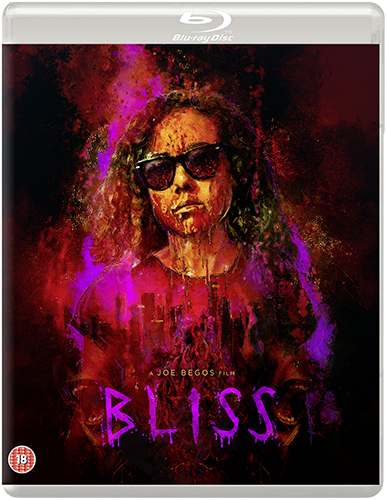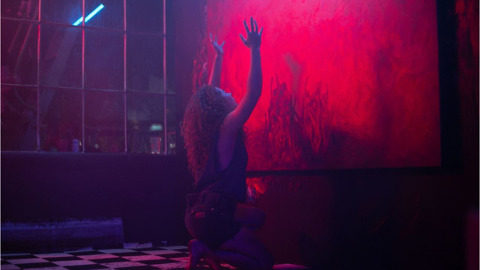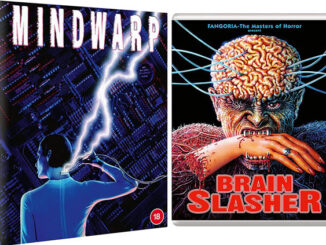Bliss (2019)
Directed by: Joe Begos
Written by: Joe Begos
Starring: Dora Madison, Jeremy Gardner, Rhys Wakefield, Tru Collins
USA
AVAILABLE ON BLU-RAY: 10TH FEBRUARY, from EUREKA ENTERTAINMENT
RUNNING TIME: 80 mins
REVIEWED BY: Dr Lenera, Official HCF Critic
Dezzy is a painter who hasn’t been able to paint anything in months. She’s behind with her rent and is dropped by her agent when she hasn’t produced the picture she’s supposed to have finished by now. Seeking solace with old friends and old vices she thought she’d left behind in the sleazy underbelly of Los Angeles, she finds herself going down a dark path which results in her being able to paint, but which also takes her into a new and even more dangerous addiction than a hallucinogenic drug named Diablo….
Can the creative impulse be enhanced by consuming ‘something’? I think that the answer is – on some instance – yes, whether one considers this to be a good or bad thing. Hell, I’m not convinced that music would have evolved the way that it did if it hadn’t been for drugs. Half of the pop albums now regarded as classics were probably created in a haze of marijuana, psychedelics or Bolivian marching powder, while dance music probably wouldn’t even exist if it hadn’t been for a certain something called ecstasy. And I reckon that similar claims could be made with regard to any art form. I’m not at all making claims for me being a film reviewer of particular note, but I will confess to you one thing – there are times when a glass or more of vino aids me in doing a write-up, especially if my head is swirling with what I’ve just watched. There have even been times – though not that many – when I’ve got myself a bit tipsy while bashed out a review, and, when I’ve checked it the morning after the result has turned out to be among my best work, even if the spelling and grammar need some improvement. Bliss, which is most definitely not the first film with that moniker [though we live in age of oft-used one word titles being trotted out yet again], is partly based on the concept that art can come from not being entirely ‘with it’, which is one reason why I found it fascinating, though thankfully I’ve never woken up and not remembered writing a review at all, unlike the poor heroine of Joe Begos’ film who doesn’t recall her painting. Nor have I began to get a thirst for a certain something and started to kill people – yet.
Begos is not a filmmaker I’ve encountered before, but I know that his Almost Human and The Mind’s Eye are kind of ‘80s throwbacks. Bliss is less so, though old school fans will cheer at its use of practical special effects, and it still wears its influences very much on his sleeve, notably the work of Gaspar Noe and Abel Ferrera. Some will also notice similarities with The Devil’s Candy and Near Dark, so you could say that Bliss is pretty much a very stylish reworking of themes and even visuals that we’ve all seen before. However, it does make some tweaks such as having its tormented artist be a woman for a change, and the tightly-paced eighty minutes manages to be quite an experience in its own right, though the almost continuous strobe lighting [I’m not sure I’ve ever seen so much of the stuff in a movie, the warning at the beginning being definitely necessary], dizzying camerawork and jump cuts, often with heavy metal blasting away, eventually becomes a bit too overwhelming for its own good – though I guess that is kind of the point. Despite what I was saying earlier, the fact that Dezzy, after suffering from painter’s block [even if that isn’t a proper term, it ought to be!], seems able to put brush to canvas while totally off her head on a substance describe to her as, “the closest thing you’ve got to a pure uncut of cocaine and DMT” is hardly portrayed as a good thing considering all the bad stuff that also happens. There’s no glamourising of illicit substances here, though Bego does seem to slightly have Noe’s fascination with decadence, unafraid to depict the sex and drug fueled underground with a kind of relish [even if he’s far less explicit] and show how inviting it is before things start to badly go wrong. And his film has a terrific, no-holds-barred performance from his female lead Dora Madison who was clearly faced with a very difficult task; how to create sympathy for a character who’s continually rude to those around her. There are times when she actually succeeds in doing this!
The punk music and graffiti-like opening titles against a green and red flashing wall immediately grab the attention, as does the fact that Dezzy uses the f*** word ten times in about five minutes, though to be fair it does come across as part of her character rather than just being lazy writing. We learn that she was a fairly successful painter [though it doesn’t quite come through] and that she had a serious drug problem until a few months ago, though one gets the sense that her extreme defensiveness is a result of lots of hard knocks. We first see her looking over a canvas that is supposed to be turned in for a gallery and all she has is the base, a sort of red mass with a hole in the middle. Her boyfriend, Clive, asks her to give him a ride, and her landlord, Lance, yells at her as she’s behind on her rent and he threatens to throw her out. She goes to see her agent, David, who asks her about the piece that she was supposed to be finished with. She asks for an extension, but he tells her that he needs something now. She tells him that she can’t do that, so he drops her. This causes her to go into somewhat of a tailspin and she calls up an old friend and dealer named Hadrian. When she visits his house, we get the first showing of the extreme visual style which will soon take over the film, though it’s fairly muted here, with a lovely composition of people playing cards lit by a visible green light while the curtains are bathed in red from another light right on the side of the screen. He gives her something called ‘Diablo’ – nicknamed ‘Bliss’ – which he warns about having too much of. As she lies down, we see the ceiling start to move slightly and then cut to her face having some strange, unsettling reflections of something appear just a little on it. She of course goes on a bender and ends up having a threesome with two pals, Courtney and Ronnie, seeming to slightly become a bit ‘different’ during the sex.
She does actually do some painting, but doesn’t remember. When she was ‘sober’, she couldn’t paint, though she wasn’t ‘totally’ sober seeing as she never gave up alcohol and marijuana, just the ‘hard’ stuff. The moment she relapses though, she is creative again. Well, some artists apparently do need to be ‘opened up’ in order to be able to produce. Dezzy’s painting develops and is clearly depicting lost souls in Hell. Some of the best scenes have her painting with great passion, and, while the heavy metal music in these bits isn’t my ‘thing’, we get a real sense of liberation. However, this doesn’t make her a nicer person. Some may understandably find it a flaw or even a major problem that this character, a woman who’s rude to another lady wanting to use the toilet she’s been using for fifteen minutes, who’s rude to a fan, and who says that she’ll get rid of Clive [who doesn’t seem to be a bad sort, just not very bright] “when something better comes along”, fails to develop, but I liked it. After all, not everyone changes in real life do they, no matter what happens. Dezzy keeps on taking the drug and on one occasion has a bad reaction and feels like she’s going to die, but then someone comes along to enlighten her about what’s really going on and she wakes up with blood all over her. It’s hardly been kept a surprise that vampirism is a part of this story, and therefore some of what follows you will probably guess, though vampire lore is sometimes twisted – just look at the number of scenes featuring Dezzy and mirrors.
Bliss is pretty gritty and downbeat in its fatalistic depiction of blood lust. Here, it’s certainly no fun being a vampire. Details are kept vague – takers of Diablo become vampires and that’s about it. The vampire attacks are some of the messiest you will probably have seen in a while, bringing to mind the gruesome ones in Vampyres and The Living Dead Girl. Necks are not the only recipients for teeth; any part of the body, but especially the face, can be ripped into. The flashing lighting means that some of the bloody visuals are only partly seen, but none the less there’s plenty here to fuel the horror fan’s blood lust, especially if he or she is nostalgic for the days before the computers took over. There are some good ‘melting’ scenes, achieved on a very small budget. But towards the end one gets a sense that Bego wasn’t quite sure how to conclude things, even though he does eventually do so in a manner that’s probably logical in the world of this film, a film where – from the moment Dezzy snorts the powder – Begos and cinematographer Mike Testin saturate us in rich reds, greens and blues. Combined with the constant whirling of the camera all over the place and frantic editing, I’m rather glad that I didn’t see this in the cinema. Some of it is striking, like when Dezzy is walking round and round her apartment while the camera keeps on going round and round her, and also when Dezzy and Courtney are at a gig, spinning round and round while the painting can be partly seen in the background. But it does becomes a bit tiring, even if one accepts that it’s probable that the viewer was meant to find it tiring, fitting in with the anti-drug theme – and it hampers some of the climactic action in terms of visibility. However, the colour schemes are always well managed in what is a largely interior film, and we get so used to the neon universe that whenever we briefly switch to an outdoor location, we struggle to adjust to the naturalistic look, though check out the final daytime scene – the nighttime green is starting to slightly bleed through.
Less successful are what look like some post-production scratches and deliberately heavy grain; they temporarily take us out of the trip and remind us of things like Quentin Tarantino and Grindhouse. But it’s evident that a lot of thought has been put in to the visuals, and also the aural aspects too. The music certainly isn’t all death metal; there’s punk, ambient and even some Tangerine Dream-like electronica, it all combining to create a vivid landscape for its main protagonist and us to stumble about in. Of course likening substance abuse to vampirism is hardly a new thing, and Ferrera probably did it best with The Addiction. Much as I’ve had an almost lifelong love for vampires despite what the Twilight series did to besmirch their good name, I do wonder if it would have been better if Begos had not introduced the vampire angle at all, an angle which doesn’t seem fully thought through here. He could have still had Dezzy do some very bad things. Saying that, there does seem to be the vague suggestion – that not too obvious as has become the rather tiresome norm – that much of what we see could be happening in Dezzy’s head. But then it’s probably best not to think about things too much when watching Bliss. Just try to enjoy the sensory experience. And if it does become too ‘heavy’ – well – you’ll still most definitely be able to appreciate Madison’s fearless, full-on yet convincing acting in the lead role, a rare actress who we learn apparently chose to do more nudity then was in the script. It’s been a while since I’ve felt such compassion and even empathy for such a self-defeating character who in real life would probably tell me to “f*** off” as soon as I spoke to her, even if I did so in as nice a fashion as possible.
Rating: 









I mentioned some heavy grain and even some scratches in the paragraph immediately above this one which I’m sure were put in on purpose. The stunning picture quality of the majority of this cheaply made film backs this up, and actually the look of the film shows up the particular qualities of 15mm. The colours could not be more vibrant yet there’s a certain rawness which fits with the camera style and the subject matter. Meanwhile the sound mix is extremely well balanced and not always in your face.
Eureka go one up on the Region ‘A’ release from Dark Sky Films by adding an extra audio commentary. It’s from Kat Ellinger, who you may be familiar with from some Arrow releases, and her ‘Daughters of Darkness’ podcast buddy Samm Deighan. There are no gaps as they delve into subtext and link this to other cycles of films and indeed literature. It’s noted that there are an increasing number of very stylised, unconventional horror films coming out these days, that Bliss seems to also be part of a cycle where characters seem lost as in the ’40s, and how it’s still almost a taboo to have a female lead character like this, one who behaves like a man. The relaxed, chatty pair clearly find the film fascinating but agree that it doesn’t seem to be sure where it’s going. The other two commentaries are just as worthwhile, perhaps more so. Begos, who can’t seem to stop using the f*** word, and Madison, who employs it quite a bit too and who seems so excitable that I wondered if she was knocking back the booze while doing the track, are full of observations and stories despite the swearing. We learn that she largely based her character on two painters she knew – both of whom weren’t currently able to paint, that scenes often evolved on set, and that the owner of the car used found the pretend Bliss in it! Both seemed to love making the film. The third commentary, despite Begos, producer Josh Ethier and special effects artists Josh and Sierra Russell focusing more on the technical side of things, is even better, the non-stop chat flowing nicely and sometimes hitting heights of enthusiasm as we here how footage was shot on the sly, how they got blood all over ‘Elvis’s sofa’, and how the huge crew of Once Upon A Time In Hollywood would pass by their tiny outfit. Great stuff.
Both commentary two and three mention deleted footage. An epilogue and some stuff on an elevator are not present on the Blu-ray, but we are able to see the original opening which is very dramatic. It features a vampire attack and a chase, but Bego was wise to remove it.
The talk tracks emphasise how micro budgeted this film was which raises it further in my estimation. I’m sure that many viewers won’t have my minor quibbles about the cinematographic style. Reworking well worn themes but still feeling fresh, Bliss proves that there’s life in the old blood suckers yet. Recommended.
SPECIAL FEATURES
*1080p presentation of the film on Blu-ray
*5.1 DTS-HD MA and uncompressed LPCM 2.0 audio options
*Optional English subtitles
*Brand new audio commentary with film historians Kat Ellinger and Samm Deighan (Daughters of Darkness podcast)
*Audio commentary with director Joe Begos and actress Dora Madison
*Audio Commentary by director Joe Begos, producer Josh Ethier, and the Russell FX team
*Deleted Scene
*Trailer








Be the first to comment